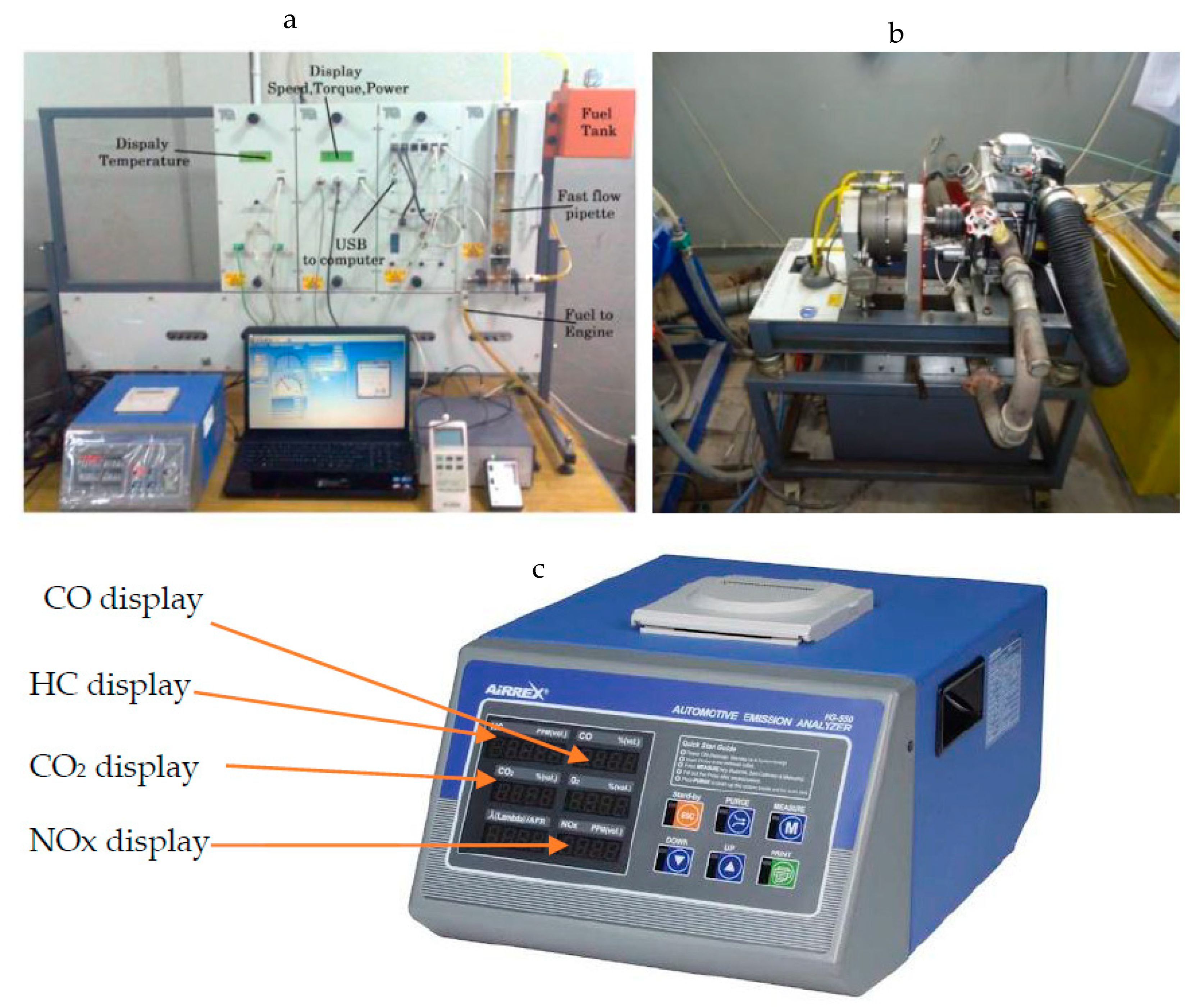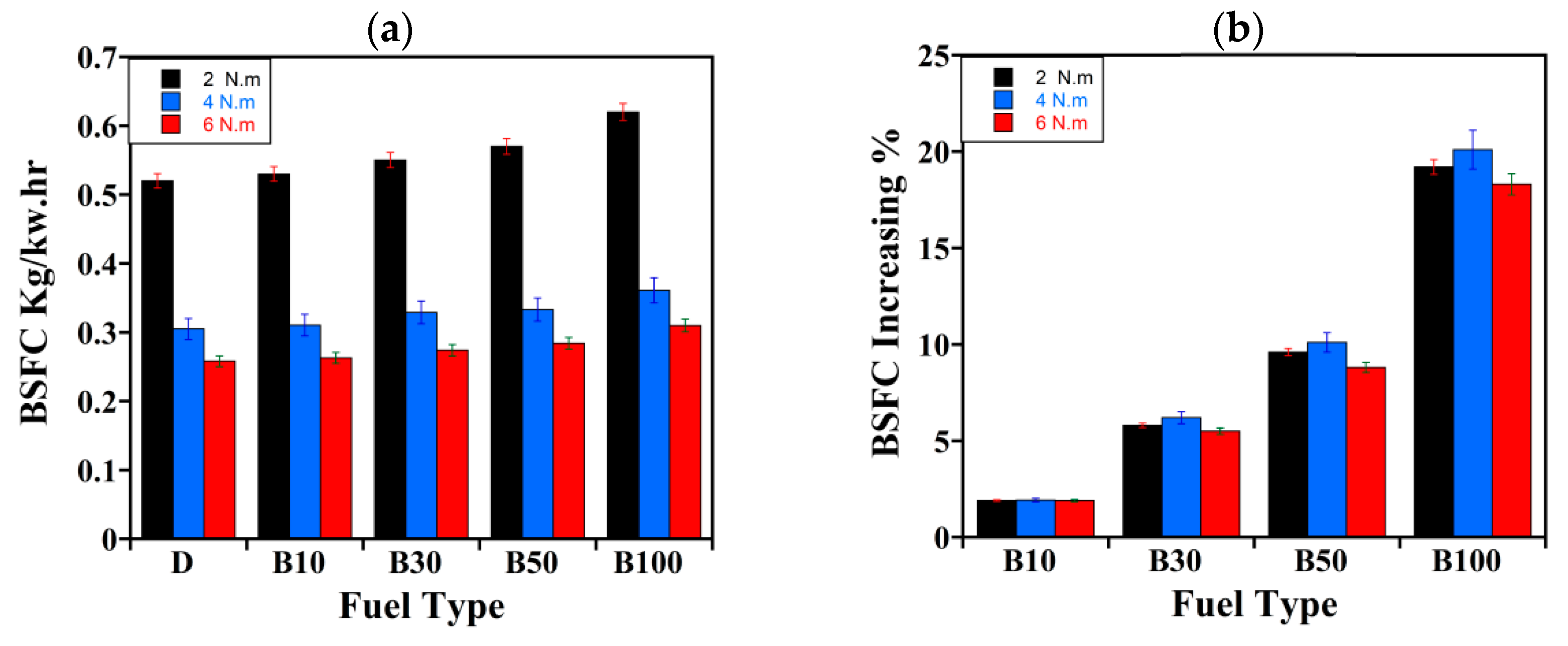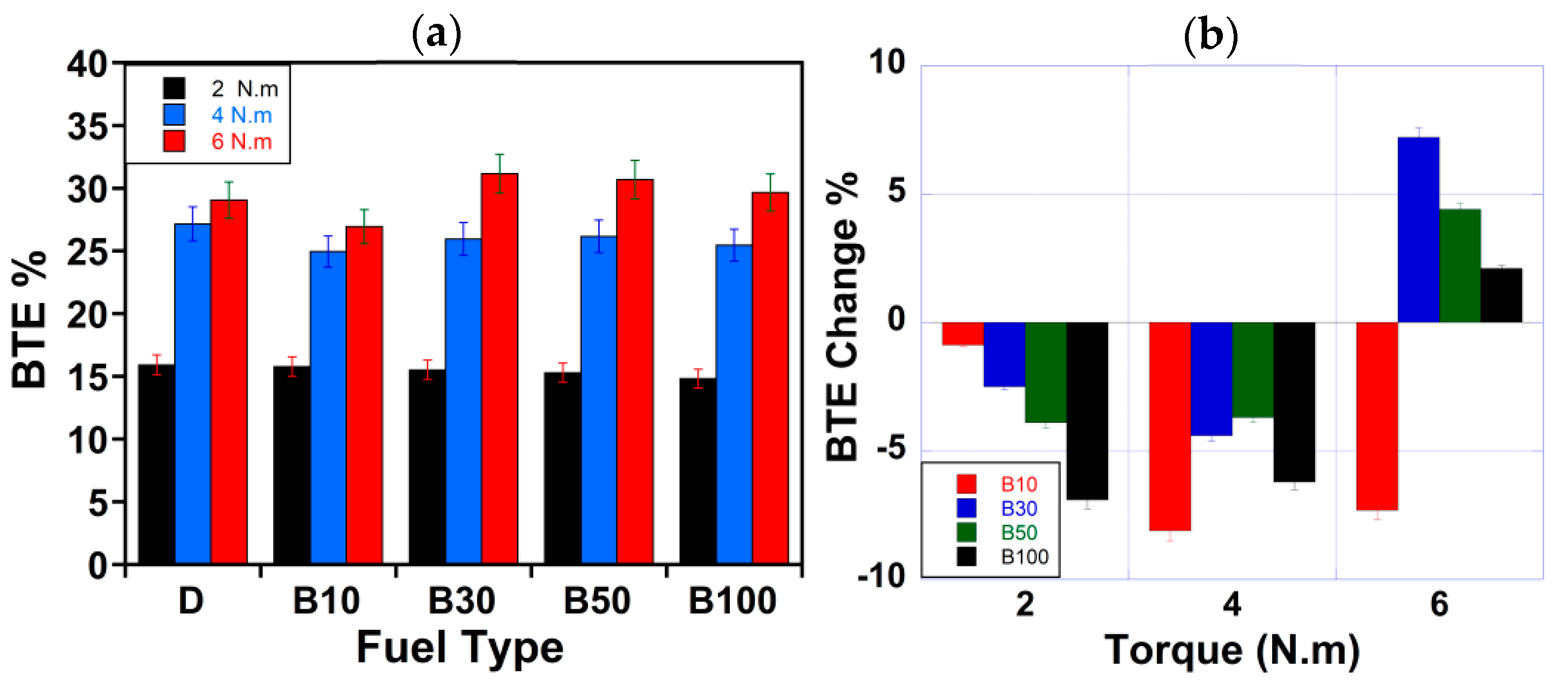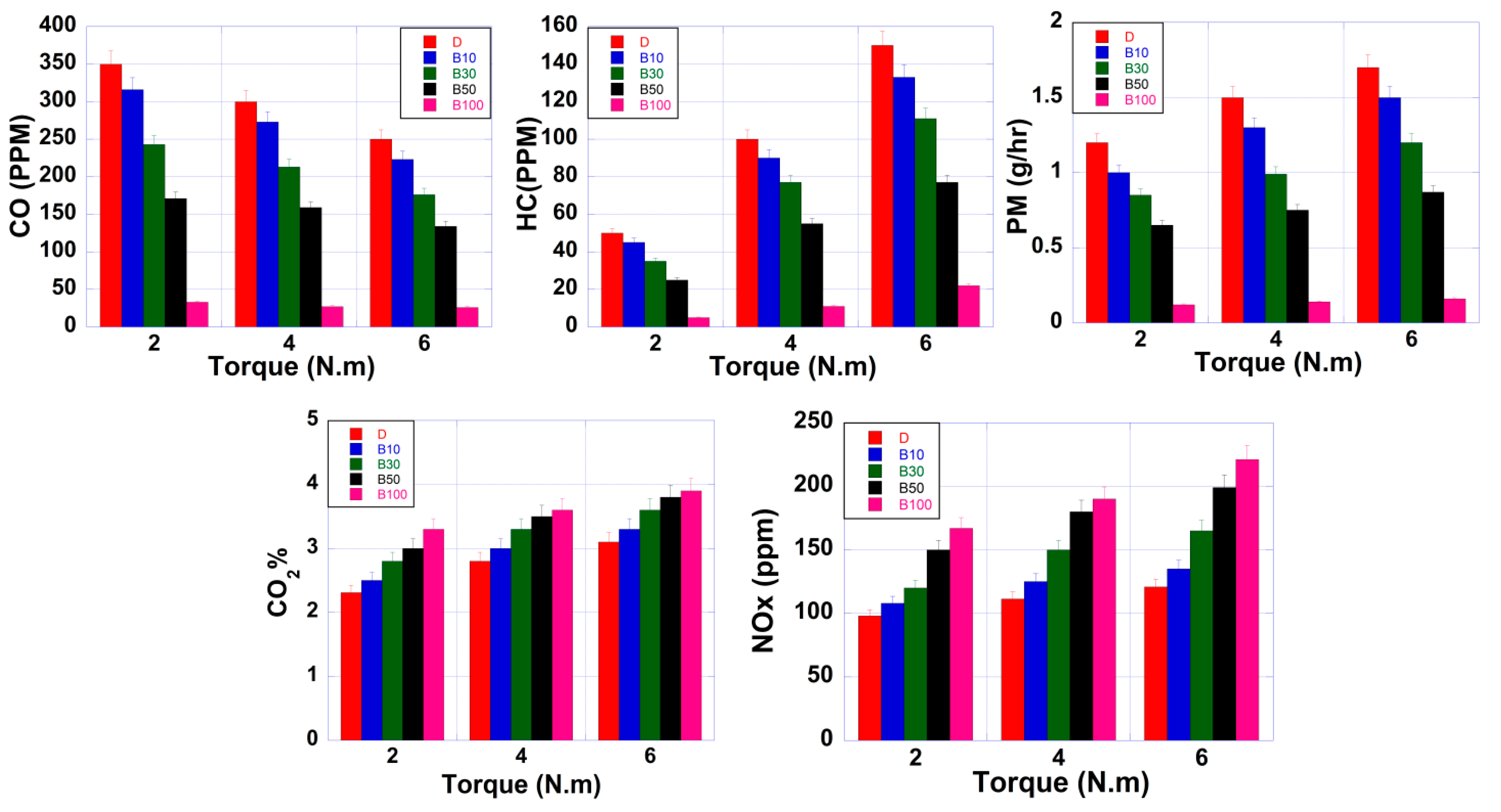The Impact of Utilizing Waste Sunflower Oil as a Biodiesel Blend on Four-Stroke Engine Performance and Emissions
Abstract
1. Introduction
2. Research Materials and Methods
2.1. Biodiesel Production
2.2. Engine Tests
2.3. Tested Parameters
2.4. Emission and Noise Tests
3. Results and Discussion
3.1. Engine Performance
3.2. Exhaust Gas Emissions
4. Conclusions
- Increasing the blending ratio increases the consumption of fuel and BSEC due to the lower heating value of biodiesel compared to petroleum diesel.
- B10 shows higher Ne than diesel fuel, which is probably due to the higher oxygen content of the biodiesel, while B30 shows a small reduction in Ne, due to the lower calorific value and higher viscosity of biodiesel compared with that of petroleum diesel fuel, and this lowers the fuel flow rate and combustion efficiency.
- B30 showed an acceptable reduction in BTE for the lowest load value. On the other hand, using B30 at the other load values (4 and 6 N.m) showed better efficiencies than that using B10. This variation in the BTE values indicates that there is more than one parameter effect on break thermal efficiency. At lower loads, the impact of increasing the fuel viscosity has more influence than other parameters resulting in an inferior combustion process and reduced BTE. On the other hand, blended fuels have lower heating values compared to diesel, which reduces the heat transfer losses, and enhances the thermal efficiency at higher load values.
- Blending biodiesel with diesel resulted in a cooling impact on the cylinder charge due to the lower heating value of biodiesel and its higher oxygen content. This resulted in a reduction in the peak cylinder temperature, and this reduced machine knocking and noising intensity.
- Increasing the biodiesel blending ratio resulted in a reduction in CO emissions due to the high oxygen content of biodiesel. This high reduction in HC emission was due to the better combustion of fuel resulting from the higher oxygen content of biodiesel. On the other hand, the reduction in CO, HC, and PM emissions with increasing biodiesel ratio was probably correlated with the obvious rise in CO2 emission.
- The increase in CO2 emission with an increasing biodiesel ratio was also due to increasing fuel consumption.
- The increase in NOx emission with an increasing biodiesel ratio was due to increasing fuel oxygen content and its reaction with N2 in the air at higher temperatures.
Author Contributions
Funding
Data Availability Statement
Conflicts of Interest
Nomenclature
| List of Abbreviation Symbols | Definitions |
| B100 | Pure biodiesel |
| B10 | 10% biodiesel and 90% petroleum diesel |
| BSEC | Brake-specific energy consumption |
| BSFC | Brake-specific fuel consumption |
| BTE | Brake thermal efficiency |
| COx | Carbon oxides (CO & CO2) |
| CV | Calorific value |
| D | Non-blending diesel |
| dB | Decibels |
| FM | Fuel mass flow rate |
| HC | Hydrocarbons |
| LHV | Lower heating value (MJ/kg) |
| mºf | Fuel consumption rate (g/s) |
| N | Speed (rpm) |
| Ne | Engine effective power |
| NOx | Nitrogen oxides (NO & NO2) |
| P.B | Power produced (W) |
| PM | Particulate matter |
| T | Engine brake load (N.m) |
| ηbth | Noise intensity |
References
- Shaker, F.N.; Obed, A.A.; Abid, A.J.; Saleh, A.L.; Hassoon, R.J. Energy Management Strategy for PV PSO MPPT/Fuel Cell/Battery Hybrid System with Hydrogen Production and Storage. J. Tech. 2023, 5, 52–60. [Google Scholar] [CrossRef]
- Mohammed, M.M.; Alalwan, H.A.; Alminshid, A.; Hussein, S.A.M.; Mohammed, M.F. Desulfurization of heavy naphtha by oxidation-adsorption process using iron-promoted activated carbon and Cu+2-promoted zeolite 13X. Catal. Commun. 2022, 169, 106473. [Google Scholar] [CrossRef]
- Mohammed, A.S.; Atnaw, S.M.; Ramaya, A.V.; Alemayehu, G. A comprehensive review on the effect of ethers, antioxidants, and cetane improver additives on biodiesel-diesel blend in CI engine performance and emission characteristics. J. Energy Inst. 2023, 108, 101227. [Google Scholar] [CrossRef]
- Sedef, K.; AYLANŞIK, G.; Babagiray, M.; Kocakulak, T. Biodiesel production from waste sunflower oil and engine performance tests. Int. J. Automot. Sci. Technol. 2020, 4, 206–212. [Google Scholar]
- Zangana, L.M.K.; Yaseen, A.H.; Hassan, Q.H.; Mohammed, M.M.; Mohammed, M.F.; Alalwan, H.A. Investigated kerosene-diesel fuel performance in internal combustion engine. Clean. Eng. Technol. 2023, 12, 100591. [Google Scholar] [CrossRef]
- Gautam, R.; Kumar, S. Performance and combustion analysis of diesel and tallow biodiesel in CI engine. Energy Rep. 2020, 6, 2785–2793. [Google Scholar] [CrossRef]
- Saxena, V.; Kumar, N.; Saxena, V.K. Combustion, performance and emissions of Acacia concinna biodiesel blends in a diesel engine with variable specific heat ratio. J. Therm. Anal. Calorim. 2021, 147, 1281–1298. [Google Scholar] [CrossRef]
- Jekayinfa, S.; Adebayo, A.; Sulaiman, M.; Ayoola, V. Prediction of density and viscosity of biodiesel fuel from Fatty Acid Methyl Ester (FAME) composition. Arid. Zone J. Eng. Technol. Environ. 2019, 15, 519–533. [Google Scholar]
- Hassan, T.; Rahman, M.M.; Rahman, M.A.; Nabi, M.N. Opportunities and challenges for the application of biodiesel as automotive fuel in the 21st century. Biofuels Bioprod. Biorefining 2022, 16, 1353–1387. [Google Scholar] [CrossRef]
- Dang, H.; Wang, G.; Wang, C.; Ning, X.; Zhang, J.; Mao, X.; Zhang, N.; Wang, C. Comprehensive study on the feasibility of pyrolysis biomass char applied to blast furnace injection and tuyere simulation combustion. ACS Omega 2021, 6, 20166–20180. [Google Scholar] [CrossRef]
- Santhoshkumar, A.; Thangarasu, V.; Ramanathan, A. Experimental and empirical analysis of performance, combustion and emission characteristics of diesel engine fueled with pyrolysis waste engine oil under single and split injection strategy. Sustain. Energy Technol. Assess. 2023, 55, 102893. [Google Scholar] [CrossRef]
- Doppalapudi, A.; Azad, A.; Khan, M. Advanced strategies to reduce harmful nitrogen-oxide emissions from biodiesel fueled engine. Renew. Sustain. Energy Rev. 2023, 174, 113123. [Google Scholar] [CrossRef]
- Pullen, J.; Saeed, K. Factors affecting biodiesel engine performance and exhaust emissions—Part I. Energy 2014, 72, 17–34. [Google Scholar] [CrossRef]
- Akay, F.; Aksoy, F. Atık Zeytinyağından elde Edilen Biyodizelin Motor Performansı ve Egzoz Emisyonlarına Etkileri. Master’s Thesis, Afyon Kocatepe Üniversitesi Fen Bilimleri Enstitüsü, Afyon, Turkey, 2017. [Google Scholar]
- Hasan, M.; Rahman, M.M. Performance and emission characteristics of biodiesel–diesel blend and environmental and economic impacts of biodiesel production: A review. Renew. Sustain. Energy Rev. 2017, 74, 938–948. [Google Scholar] [CrossRef]
- Xu, H.; Ou, L.; Li, Y.; Hawkins, T.R.; Wang, M. Life cycle greenhouse gas emissions of biodiesel and renewable diesel production in the United States. Environ. Sci. Technol. 2022, 56, 7512–7521. [Google Scholar] [CrossRef] [PubMed]
- Govindhan, P.; Prabhu, N.; Edison Chandraseelan, R.; Dharmendira Kumar, M. Technologies of bio-diesel production: A state of the art review. Pet. Sci. Technol. 2024, 42, 339–356. [Google Scholar] [CrossRef]
- Ghosh, N.; Rhithuparna, D.; Rokhum, S.L.; Halder, G. Ethical issues pertaining to sustainable biodiesel synthesis over trans/esterification process. Sustain. Chem. Pharm. 2023, 33, 101123. [Google Scholar] [CrossRef]
- Sathya, K.; Nagarajan, K.; Carlin Geor Malar, G.; Rajalakshmi, S.; Raja Lakshmi, P. A comprehensive review on comparison among effluent treatment methods and modern methods of treatment of industrial wastewater effluent from different sources. Appl. Water Sci. 2022, 12, 70. [Google Scholar] [CrossRef]
- Hassan, Q.H.; Alalwan, H.; Mohammed, M.; Mohammed, M.F. Identifying the Impact of Methanol-Diesel Fuel on the Environment Using A Four-Stroke Ci Engine. J. Appl. Eng. Sci. 2023, 21, 1–6. [Google Scholar] [CrossRef]
- Mohanty, R. Internal Combustion Engines; Standard Book House: Delhi, India, 2007. [Google Scholar]
- Bayraktar, H. An experimental study on the performance parameters of an experimental CI engine fueled with diesel–methanol–dodecanol blends. Fuel 2008, 87, 158–164. [Google Scholar] [CrossRef]
- Datta, A.; Dutta, S.; Mandal, B.K. Effect of methanol addition to diesel on the performance and emission characteristics of a ci engine. J. Basic Appl. Eng. Res. 2014, 1, 8–13. [Google Scholar]
- Maniyath, S.; Rajan, R.; Vaisakh, S.; Pramith, M.; Sarath, N.; Arjun Krishna, S.; Arjun, A. Design and Fabrication of Supercharging an Engine Using Vehicle Suspension. Appl. Mech. Mater. 2015, 798, 239–245. [Google Scholar] [CrossRef]
- Çakmak, A.; Bilgin, A. Exergy and energy analysis with economic aspects of a diesel engine running on biodiesel-diesel fuel blends. Int. J. Exergy 2017, 24, 151–172. [Google Scholar] [CrossRef]
- Krishnasamy, A.; Bukkarapu, K.R. A comprehensive review of biodiesel property prediction models for combustion modeling studies. Fuel 2021, 302, 121085. [Google Scholar] [CrossRef]
- Kumar, C.; Babu, M.G.; Das, L.M. Experimental Investigations on a Karanja Oil Methyl Ester Fueled DI Diesel Engine. SAE Technical Paper. In Proceedings of the SAE World Congress 2006, Detroit, MI, USA, 3–6 April 2006. [Google Scholar]
- An, H.; Yang, W.; Chou, S.; Chua, K. Combustion and emissions characteristics of diesel engine fueled by biodiesel at partial load conditions. Appl. Energy 2012, 99, 363–371. [Google Scholar] [CrossRef]
- Afzal, A.; Soudagar, M.E.M.; Belhocine, A.; Kareemullah, M.; Hossain, N.; Alshahrani, S.; Saleel C, A.; Subbiah, R.; Qureshi, F.; Mujtaba, M.A. Thermal performance of compression ignition engine using high content biodiesels: A comparative study with diesel fuel. Sustainability 2021, 13, 7688. [Google Scholar] [CrossRef]
- Rajak, U.; Verma, T.N.; Allamraju, K.V.; Kumar, R.; Le, Q.H.; Pugazhendhi, A. Effects of different biofuels and their mixtures with diesel fuel on diesel engine performance and exhausts. Sci. Total Environ. 2023, 903, 166501. [Google Scholar] [CrossRef] [PubMed]
- Dwivedi, G.; Jain, S.; Sharma, M. Impact analysis of biodiesel on engine performance—A review. Renew. Sustain. Energy Rev. 2011, 15, 4633–4641. [Google Scholar] [CrossRef]
- Khaskheli, A.A.; Arain, H.J.; Memon, I.A.; Rajput, U.A.; Ahsan, M.J. Emission and Noise Characteristics of a Diesel Engine Fuelled with Diesel-Chicken Oil Biodiesel Blends. Eng. Technol. Appl. Sci. Res. 2020, 10, 5387–5391. [Google Scholar] [CrossRef]
- Ağbulut, Ü.; Karagöz, M.; Sarıdemir, S.; Öztürk, A. Impact of various metal-oxide based nanoparticles and biodiesel blends on the combustion, performance, emission, vibration and noise characteristics of a CI engine. Fuel 2020, 270, 117521. [Google Scholar] [CrossRef]
- Huang, Z.; Huang, J.; Luo, J.; Hu, D.; Yin, Z. Performance enhancement and emission reduction of a diesel engine fueled with different biodiesel-diesel blending fuel based on the multi-parameter optimization theory. Fuel 2022, 314, 122753. [Google Scholar] [CrossRef]
- Wang, D.; Xie, Z.; Porosoff, M.D.; Chen, J.G. Recent advances in carbon dioxide hydrogenation to produce olefins and aromatics. Chem 2021, 7, 2277–2311. [Google Scholar] [CrossRef]
- Xi, Z.; Li, M.; Li, X.; Lu, L.; Wang, J. Reaction mechanisms involving the hydroxyl radical in the low-temperature oxidation of coal. Fuel 2022, 314, 122732. [Google Scholar] [CrossRef]
- Wagemakers, A.; Leermakers, C. Review on the effects of dual-fuel operation, using diesel and gaseous fuels, on emissions and performance. SAE Int. J. Engines 2012, 2012010869, 1–18. [Google Scholar]
- Nilesh, L.B.; Christopher, J.R.; David, E.F.; Kushal, N.; Yongsheng, H. CO Emission Model for an Integrated Diesel Engine Emissions and Exhaust Aftertreatment System Level Model. In Proceedings of the SAE World Congress & Exhibition 2009, Detroit, MI, USA, 20–23 April 2009. [Google Scholar]
- Iodice, P.; Cardone, M. Ethanol/gasoline blends as alternative fuel in last generation spark-ignition engines: A review on CO and HC engine out emissions. Energies 2021, 14, 4034. [Google Scholar] [CrossRef]
- Nagappan, M.; Devaraj, A.; Babu, J.; Saxena, N.V.; Prakash, O.; Kumar, P.; Sharma, A. Impact of additives on Combustion, performance and exhaust emission of biodiesel fueled direct injection diesel engine. Mater. Today Proc. 2022, 62, 2326–2331. [Google Scholar] [CrossRef]
- Elbanna, A.M.; Xiaobei, C.; Can, Y.; Elkelawy, M.; Bastawissi, H.A.-E.; Panchal, H. Fuel reactivity controlled compression ignition engine and potential strategies to extend the engine operating range: A comprehensive review. Energy Convers. Manag. X 2022, 13, 100133. [Google Scholar]
- Parthasarathy, M.; Ramkumar, S.; Elumalai, P.; Gupta, S.K.; Krishnamoorthy, R.; Iqbal, S.M.; Dash, S.K.; Silambarasan, R. Experimental investigation of strategies to enhance the homogeneous charge compression ignition engine characteristics powered by waste plastic oil. Energy Convers. Manag. 2021, 236, 114026. [Google Scholar] [CrossRef]
- Kalwar, A.; Singh, R.K.; Gupta, A.; Rajak, R.; Gosakan, G.; Agarwal, A.K. Particulates, unregulated and regulated emissions and catalytic converter efficiency evaluation of methanol (M15) fuelled BS-VI compliant light-duty spark-ignition engine. Sci. Total Environ. 2023, 902, 166047. [Google Scholar] [CrossRef]
- Wang, Y.; Liu, H.; Lee, C.-F.F. Particulate matter emission characteristics of diesel engines with biodiesel or biodiesel blending: A review. Renew. Sustain. Energy Rev. 2016, 64, 569–581. [Google Scholar] [CrossRef]
- Cheng, A.; Dibble, R.W.; Buchholz, B.A. The effect of oxygenates on diesel engine particulate matter; SAE Technical Paper. SAE Technical Paper. In Proceedings of the SAE 2002 Spring Fuels & Lubricants Meeting & Exhibition, Reno, NV, USA, 6–9 May 2002. [Google Scholar]
- Hosseinzadeh-Bandbafha, H.; Kumar, D.; Singh, B.; Shahbeig, H.; Lam, S.S.; Aghbashlo, M.; Tabatabaei, M. Biodiesel antioxidants and their impact on the behavior of diesel engines: A comprehensive review. Fuel Process. Technol. 2022, 232, 107264. [Google Scholar] [CrossRef]
- Kozak, M.; Merkisz, J. Oxygenated diesel fuels and their effect on PM emissions. Appl. Sci. 2022, 12, 7709. [Google Scholar] [CrossRef]
- Razak, N.H.; Hashim, H.; Yunus, N.A.; Klemeš, J.J. Reducing diesel exhaust emissions by optimisation of alcohol oxygenates blend with diesel/biodiesel. J. Clean. Prod. 2021, 316, 128090. [Google Scholar] [CrossRef]
- Mourad, M.; Mahmoud, K.R.; NourEldeen, E.-S.H. Improving diesel engine performance and emissions characteristics fuelled with biodiesel. Fuel 2021, 302, 121097. [Google Scholar] [CrossRef]
- Leach, F.; Kalghatgi, G.; Stone, R.; Miles, P. The scope for improving the efficiency and environmental impact of internal combustion engines. Transp. Eng. 2020, 1, 100005. [Google Scholar] [CrossRef]








| Type of Fuel | Fuel’s Density (kg/m3) | Fuel’s Kinematic Viscosity (cSt) at 40 | Calorific Value (CV) (KJ/Kg) | Cetane Number | LHV (MJ/kg) | Latent Heat of Vaporization (kJ/kg) |
|---|---|---|---|---|---|---|
| Diesel | 839.00 ± 1.00 | 2.449 | 43,464.71 | 55.95 | 42.5 | 249.1 ± 1.00 |
| B10 | 840.44 ± 1.00 | 2.70 | 43,034.21 | 56.35 | 42.0 | 250.5 ± 1.00 |
| B30 | 851.61 ± 1.00 | 3.11 | 42,173.45 | 57.20 | 41.0 | 251.5 ± 1.00 |
| B50 | 862.5 ± 1.00 | 3.51 | 41,312.60 | 58.05 | 40.5 | 252.5 ± 1.00 |
| B100 | 884.00 ± 1.00 | 4.490 | 39,160.50 | 60.10 | 37.5 | 254.0 ± 1.00 |
Disclaimer/Publisher’s Note: The statements, opinions and data contained in all publications are solely those of the individual author(s) and contributor(s) and not of MDPI and/or the editor(s). MDPI and/or the editor(s) disclaim responsibility for any injury to people or property resulting from any ideas, methods, instructions or products referred to in the content. |
© 2024 by the authors. Licensee MDPI, Basel, Switzerland. This article is an open access article distributed under the terms and conditions of the Creative Commons Attribution (CC BY) license (https://creativecommons.org/licenses/by/4.0/).
Share and Cite
Hassan, Q.H.; Araibi, A.S.; Shather, A.H.; Mohammed, M.M.; Alalwan, H.A. The Impact of Utilizing Waste Sunflower Oil as a Biodiesel Blend on Four-Stroke Engine Performance and Emissions. Designs 2024, 8, 38. https://doi.org/10.3390/designs8030038
Hassan QH, Araibi AS, Shather AH, Mohammed MM, Alalwan HA. The Impact of Utilizing Waste Sunflower Oil as a Biodiesel Blend on Four-Stroke Engine Performance and Emissions. Designs. 2024; 8(3):38. https://doi.org/10.3390/designs8030038
Chicago/Turabian StyleHassan, Qais Hussein, Alaa Salahuddin Araibi, Akram Hatem Shather, Malik Mustafa Mohammed, and Hayder Abdulkhaleq Alalwan. 2024. "The Impact of Utilizing Waste Sunflower Oil as a Biodiesel Blend on Four-Stroke Engine Performance and Emissions" Designs 8, no. 3: 38. https://doi.org/10.3390/designs8030038
APA StyleHassan, Q. H., Araibi, A. S., Shather, A. H., Mohammed, M. M., & Alalwan, H. A. (2024). The Impact of Utilizing Waste Sunflower Oil as a Biodiesel Blend on Four-Stroke Engine Performance and Emissions. Designs, 8(3), 38. https://doi.org/10.3390/designs8030038






